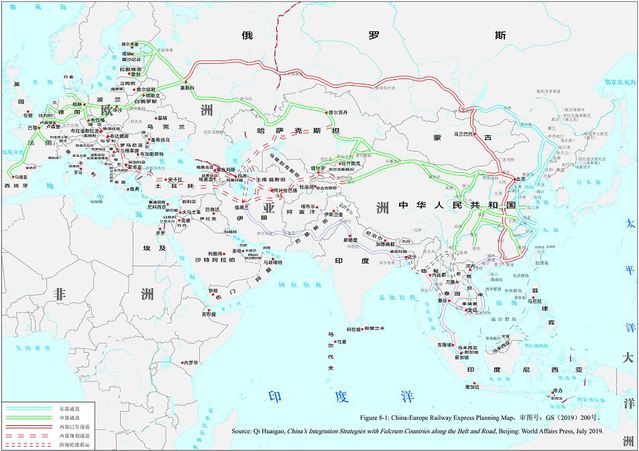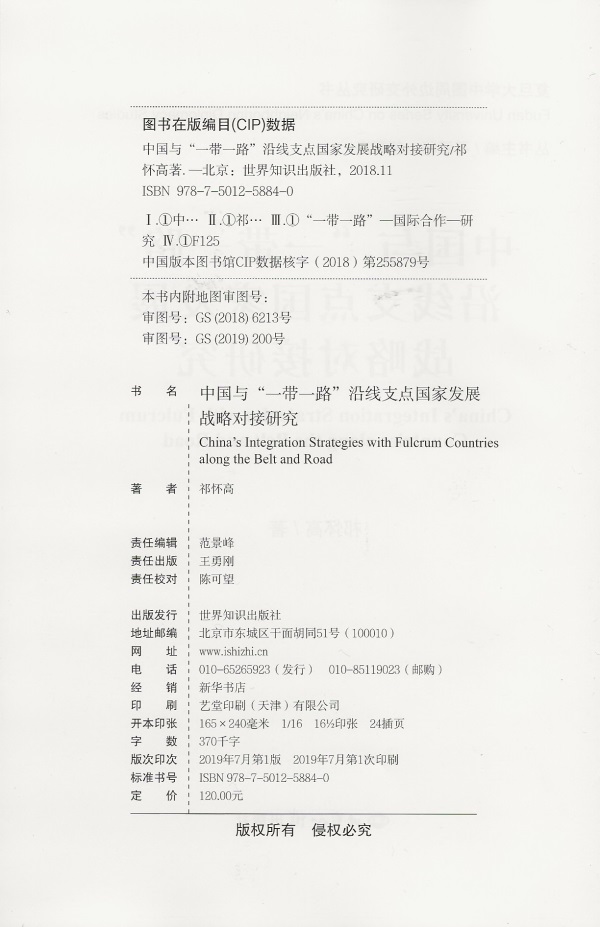Qi Huaigao, China’s Integration Strategies with Fulcrum Countries along the Belt and Road, Beijing: World Affairs Press, July 2019.
ISBN: 978-7-5012-5884-0
The title page of China’s Integration Strategies with Fulcrum Countries along the Belt and Road |
The copyright page of China’s Integration Strategies with Fulcrum Countries along the Belt and Road |
Dr. Qi Huaigao is Vice Dean and Associate Professor at Fudan University’s Institute of International Studies.
This book mainly focuses on the coordination of development strategies among China and fulcrum countries along the Belt and Road (B&R). According to a comprehensive analysis of four qualitative standards and four quantitative groups of data, this book selects six fulcrum countries and four potential fulcrum countries along the B&R as the researching target. The six fulcrum countries along the B&R are Kazakhstan (Central Asian country), Indonesia (Southeast Asian country), Pakistan (South Asian country), Poland (East European country), Greece (South European country) and Australia (South Pacific country); while the four potential fulcrum countries are Uzbekistan (Central Asian country), Malaysia (Southeast Asian country), Sri Lanka (South Asian country) and Saudi Arabia (West Asian country).
Contents
Series Editor’s Preface
Acknowledgements
List of Figures and Tables
Introduction: Selection of the fulcrum countries along the B&R
Ⅰ. Research review……1
Ⅱ. Measurement of the fulcrum countries along the B&R……6
Ⅲ. Selection of the fulcrum countries along the B&R……11
Chapter One: Coordination of the Silk Road Economic Belt and Kazakhstan’s Bright Road economy policy
Ⅰ. Kazakhstan’s economy and China-Kazakhstan economic relations……36
Ⅱ. Kazakhstan’s Bright Road economy policy……40
Ⅲ. Coordination of the Silk Road Economic Belt and Bright Road economy policy……43
Ⅳ. Some thoughts to cope with challenges……47
Chapter Two: Coordination of the 21st-Century Maritime Silk Road and Indonesia’s Global Maritime Fulcrum Strategy
Ⅰ. Indonesia’s economy and China-Indonesian economic relations……49
Ⅱ. Indonesia’s Global Maritime Fulcrum Strategy……53
Ⅲ. Coordination of the 21st-Century Maritime Silk Road and Global Maritime Fulcrum Strategy……59
Ⅳ. Some thoughts to cope with challenges……63
Chapter Three: Coordination of the BRI and Pakistan’s Vision 2025
Ⅰ. Pakistan’s economy and China-Pakistan economic relations……66
Ⅱ. Pakistan’s Vision 2025……69
Ⅲ. Construction of the CPEC and Coordination of the two countries’ development strategies……72
Ⅳ. Some thoughts to cope with challenges……75
Chapter Four: Coordination of the BRI and Poland’s Responsible Development Strategy
Ⅰ. Poland’s economy and China-Poland economic relations……78
Ⅱ. Poland’s Responsible Development Strategy……82
Ⅲ. Coordination of the BRI and Responsible Development Strategy……84
Ⅳ. Some thoughts to cope with challenges……87
Chapter Five: Coordination of the BRI and Greece’s International Logistics Transit Hub Strategy
Ⅰ. Greece’s economy and China-Greece economic relations……89
Ⅱ. Greece’s International Logistics Transit Hub Strategy……92
Ⅲ. Coordination of the BRI and International Logistics Transit Hub Strategy…95
Ⅳ. Some thoughts to cope with challenges……98
Chapter Six: Coordination of the 21st-Century Maritime Silk Road and Australia’s Developing Northern Australia
Ⅰ. Australia’s economy and China-Australian economic relations……100
Ⅱ. Australia’s Developing Northern Australia……104
Ⅲ. Coordination of the 21st-Century Maritime Silk Road and Developing Northern Australia……109
Ⅳ. Some thoughts to cope with challenges……112
Chapter Seven: Coordination of the BRI and development strategies of four potential fulcrum countries
Ⅰ. Coordination of the Silk Road Economic Belt and Uzbekistan’s Development Strategy of Actions……114
Ⅱ. Coordination of the BRI and Malaysian Economic Transformation Programme……127
Ⅲ. Coordination of the 21st-Century Maritime Silk Road and Sri Lanka’s Vision 2025 ……137
Ⅳ. Coordination of the BRI and Saudi Arabia’s Vision 2030……149
Conclusion:
Ⅰ. Making the fulcrum countries as the hubs of connectivity ……160
Ⅱ. Integrating China’s domestic institution with those of the fulcrum countries……167
Ⅲ. Accommodating the interests of the U.S., Japan, Russia, India and the EU ……171
Ⅳ. Coordinating the fulcrum countries with China’s greater neighboring diplomacy……180
Ⅴ. Connecting Eurasian partnership with Indo-Pacific partnership……183
Appendix:
Related data of Countries along the Belt and Road (2017) ……191
Coordination of the BRI and development strategies of other B&R countries……197
Bibliography
Chinese References……225
English References……236
Map of the countries along the Belt and Road,审图号:GS(2018)6213号

![]() Map of the countries along the Belt and Road, 审图号:GS(2018)6213号_清晰版本下载.pdf
Map of the countries along the Belt and Road, 审图号:GS(2018)6213号_清晰版本下载.pdf
Source: Qi Huaigao, China’s Integration Strategies with Fulcrum Countries along the Belt and Road, Beijing: World Affairs Press, July 2019.
Figure 8-1: China-Europe Railway Express Planning Map,审图号:GS(2019)200号

![]() China-Europe Railway Express Planning Map,审图号:GS(2019)200号_清晰版本下载.pdf
China-Europe Railway Express Planning Map,审图号:GS(2019)200号_清晰版本下载.pdf
Source: Qi Huaigao, China’s Integration Strategies with Fulcrum Countries along the Belt and Road, Beijing: World Affairs Press, July 2019.








